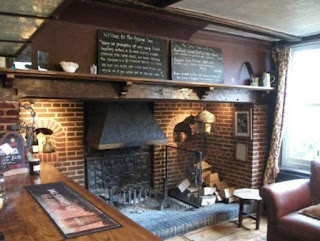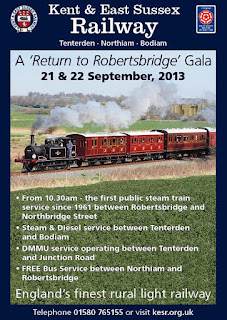 |
| Robertsbridge High Street |
My friend
Eric and I hadn’t intended to go to
Robertsbridge, yesterday. Our original plan was to travel one stop further down the line to the town of
Battle, where we had earmarked a couple of pubs to visit. Eric had been to the
Bull, back in the summer, so it looked like a good option, and we also intended to visit the
George as well.
The town of
Battle grew up around the
Abbey, which was erected on the site of the most famous battle in English history, by the victor,
Duke William of Normandy. On 14th October 1066, the area witnessed the most celebrated confrontation to take place on English soil – the
Battle of Hastings; an event so significant it completely changed the course of
English history.
Following the battle
William the Conqueror built
Battle Abbey, as a penance ordered by the
Pope for the loss of life incurred in the conflict. Today, Battle is a thriving market town featuring Georgian and medieval cottages amongst a host of interesting shops, restaurants, historic pubs and tea-rooms.
 |
| Battle Abbey |
It seemed the ideal place to visit and with easy access by direct train from
Tonbridge, we could be there in just under 40 minutes. Ideal, that is, until
Network Rail placed a weekend closure on the line between nearby
Robertsbridge and
Hastings,
in order to carry out essential engineering works. Eric had phoned me
the previous day, to report the bad news so we agreed to each
investigate other possibilities and then report back.
I looked at several options, but as well as somewhere with a decent pub
(or pubs) serving good beer, I wanted a place which offered
reasonably-priced food; something not always readily available on a
Saturday evening. Quite independently we both decided on
Robertsbridge; one stop nearer to home, and the place where trains would be terminating and the rail-replacement buses would be taking over.
We had noticed the village supports two pubs; with a third currently closed. The
Ostrich Hotel, virtually

opposite the station, looked the best bet so far as the reasonably-priced food was concerned, but the
George Inn in the centre of the village, also looked worthy of closer inspection.
Robertsbridge is a large village which dates back to the 12th Century, when a
Cistercian Abbey was founded there. The latter was dissolved in 1538, on the orders of that well-know
Tudor vandal,
Henry VIII, but the town continued to prosper and today contains some attractive half-timbered cottages and other buildings dating from the 14th and 15th Centuries. The opening of the
London to Hastings Railway, in 1851, brought further prosperity to the town, and the completion of a bypass in 1992, removed much of the traffic which had been choking the town.
We caught the 16:29 train from Tonbridge, travelling down through the attractive countryside of this part of the
Sussex Weald, and arrived in the village just before 17:10. After confirming the departure times for the return journey, we walked across the road to the
Ostrich Hotel, which shone out like a friendly and welcoming beacon against the gathering dusk.
 |
| Ostrich - Main Bar |
The
Ostrich Hotel opened in 1851, following the completion of the railway from London. The name is derived from the coat of arms on its sign, which are those of the lordship of the
Manor of Robertsbridge. It is a comfortable pub with a large “L”-shaped bar and separate games room and restaurant. There is also an upstairs function room. The walls are adorned with an assortment of paintings, prints and other pieces from the landlord’s collection, and there are some rather saucy Edwardian prints in the gent’s toilets. (I gather there are some in the Ladies as well). With a number of comfortable old sitting chairs, the place had the feel of a 1920’s sitting room
Harvey’s Sussex Best and
GK Old Speckled Hen were the two cask beers on offer, and I also spotted the
Curious Brew lager, which I
wrote about last week, available on keg. There was a group of walkers sat around one of the tables; we almost tripped over their boots which were stacked just inside the door!
 |
| Ostrich - Games Room |
The Harvey’s was in excellent condition, and after quizzing the friendly barmaid about the availability of meals, the landlord, who is also the chef, came over for a chat. Fish is the speciality of the house; sourced locally from
Hastings fish market, and his suggestions were either
halibut or
sea bass; both of which he’d procured that very morning. He particularly recommended the former, which neither of us could remember having tried before. We told him of our plans to try the
George Inn up the road, but confirmed we would definitely be returning to eat later, and would make our menu choices then.
We had already decided not to dine at the George, having previously on-line at the menu options for both pubs. Prices at the
George were around 50% higher than the
Ostrich, but we set off anyway, just o give the pub a try. We walked up the narrow road, which leads from the station, to the High Street, and turned right towards the George, which we could just see at the end of the road.
The George is an imposing red tiled fronted building which, before the coming of the railway, was formerly a coaching inn. The pub dates from the 18th-century, and as expected has plenty of low beams. The bar area occupies the far right of the building, and most of the drinkers were gathered here in front of the warming inglenook fireplace. There are views from the bar, back down the
High Street with the distinctive
War Memorial clock tower, erected in 1926, featuring prominently just across the green. Most of the interior though was given over to dining, and although there were plenty of tables laid out for dinner, none were occupied.
Beer-wise
Harvey’s Sussex Best and
Dark Star APA were available, but unfortunately the latter had run out, just as we arrived. We went for the Harvey’s again, even though the landlord said
Tonbridge Rustic was about to come on. The Sussex Best was, if anything, even better than in the Ostrich. The landlady was quite chatty, but the locals were all busy engaged in their own conversations. We both liked the
George, more than we thought we would, but as we were getting hungry, we headed off back down to the
Ostrich.
 |
| George Inn - interior |
We had missed out on the halibut, as in our absence there had been an influx of diners. Instead we each ordered an item off the lunchtime menu, which was still available. I opted for pie of the day, whilst my companion went for an omelette. We stood chatting at the bar until our food was ready and we were ushered in to the restaurant. My
steak, ale and mushroom pie was a real homemade job, and a
“proper pie” at that, with the filling completely encased in pastry. With new potatoes, green peas and carrots, plus a small jug of gravy to go with it, I was well set up. Eric’s omelette looked equally good.
We returned to the bar after our meal, and continued our pre-dinner conversation with one of the pub regulars plus, when he could spare the odd moment, the landlord. The latter told us he had bought the Ostrich from the owning brewery, back in the mid 1990’s, and described the establishment as a
“proper pub”. It certainly is a good, old-fashioned sort of pub, of the type both of us remember with affection from our youth. We chatted briefly about the potential re-opening of the
Rother-Valley branch line up to
Tenterden, and also about the
Seven Stars.
The latter is a 14th Century at the opposite end of the village to the
George. It is a
Harvey’s tied pub, which makes its current closure all the more strange, but there was talk of high rents and equally high business rates. Perhaps in today’s changing times, there just isn’t sufficient trade in a village the size of
Robertsbridge, to support three pubs.
Interestingly, the locality boasts a further pub in the nearby hamlet of
Salehurst. The
Salehurst Halt is a traditional family run pub, popular with walkers and locals. It is adjacent to a disused railway halt on the aforementioned
Rother-Valley rail line. The local sitting at the bar, had recommended it to us earlier, and had claimed it was only a 15 minute walk. A look at the map suggests it might have been a bit further, but we were happy with the two pubs visited that night, and will save a walk out to
Salehurst for the hours of daylight, and also for the warmer weather.
We caught the 21:14 train back to
Tonbridge; well-fed and
suitably refreshed. We were glad that Network Rail had scuppered our original plans, but we will make the trip out to
Battle before too long. We will also be returning to
Robertsbridge and its two excellent pubs.






















